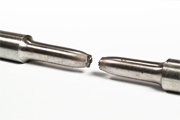 RA% is a term that stands for “reduction of area percentage.” It is an important requirement of the ASTM F1554 specification, in addition to other specifications. This value is reported as a percentage of the original test piece. When fasteners undergo mechanical testing, they are pulled to failure and the diameter of the point at which the fastener breaks is measured and compared to the original diameter. The difference between the original sample and the broken piece is calculated and reported as the reduction of area percentage.
RA% is a term that stands for “reduction of area percentage.” It is an important requirement of the ASTM F1554 specification, in addition to other specifications. This value is reported as a percentage of the original test piece. When fasteners undergo mechanical testing, they are pulled to failure and the diameter of the point at which the fastener breaks is measured and compared to the original diameter. The difference between the original sample and the broken piece is calculated and reported as the reduction of area percentage.
Each grade of ASTM F1554 has a minimum requirement to meet. For example, grade 36 has a 40% minimum reduction of area requirement which means that in order for the bolt to comply to this specification it must reduce in diameter at least 40% (or more) before breaking.
We had a result of RA% 48 against min requirement of 52% for M24x950mm anchor bolts grade 8.8 . Can this be acceptable & what will be the impact if used. What may be the cause in general when bolts failed in RA test.
@Gautam- If the minimum RA requirement is 52%, and your bolts came in at 48%, that would be grounds for rejection. However, in some cases the bolts may still be acceptable for use with a waiver. The concern with low ductility reading is that the bolts may be too brittle. Ideally bolts will break in a ductile fashion, where they give a little first, then break. Brittle bolts may snap without yielding first, and that can be a dangerous proposition in some instances.
In some cases we found UTS and YS value are same. Is it O.K.?
@Koushik- The concern when yield and tensile are quite close is that the fracture method may not be ductile but rather brittle. If your measured elongation and reduction of area are still within the allowable for the standard you are using, then you might be ok, but if they are lower than needed, that would be cause for concern.
Sir what is elongation in rolling mill plz describe
@Babar- Apologies, but we are not certain what you are asking.
Sir how we calculate area of oval 19.5/47 from square 32mm how we calculate in mm
Babar- The area of an ellipse is calculated by multiplying one radius by another, and multiplying by pi (3.14). The area of your ellipse/oval is 720mm^2.
Could you please explain why the RA% is higher in F1154 Grade 36 compare to F 1554 Grade 55 ?
@Nishad- We cannot say why the standard was originally written that way, as it was 25 years ago, but in looking through mill tests of both material, the grade 36 RA% were consistently in the 40-60 range whereas the grade 55 RA% values struggled to reach 40. Most were in the 30-40% range.